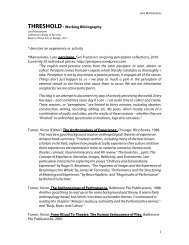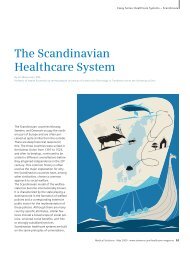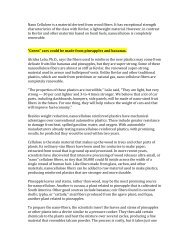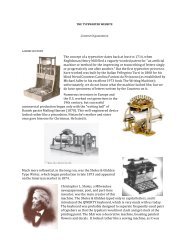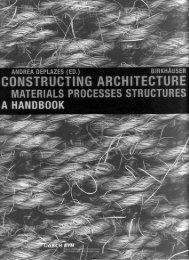Translucent Materials
Translucent Materials
Translucent Materials
You also want an ePaper? Increase the reach of your titles
YUMPU automatically turns print PDFs into web optimized ePapers that Google loves.
0.7 W/m2K, and with krypton fi I ng a<br />
U-value of 0.5 W/m K.<br />
Fitting a low-emission coated membrane<br />
avoids the weight and thickness of a third<br />
glass pane (ill. 30).<br />
Evacuating the gap can further reduce<br />
heat conduction by the enclosed gas. But<br />
it does create other problems in respect<br />
of seal tightness and thermal separation.<br />
Early vacuum glazing prototypes achieve<br />
a U-value of 0.6 W/m2K, but it will st I take<br />
some time before full industrial production<br />
is possible.<br />
Allings with thermal insulation properties<br />
Transparent heat insulators make it possi<br />
ble to reduce heat loss and at the same<br />
time gain heat from the incident sun ight<br />
(ills. 27,31).<br />
Transparent and translucent materials like<br />
glass, acrylic glass (PMMA), polycar<br />
bonate (PC) and quartz foam are used, in<br />
layers of varying thickness and structure.<br />
They are protected from the weather and<br />
mechanical damage by being bui tin<br />
between two panes (ills. 28, 30).<br />
They are classified according to four geo<br />
metrical arrangements of the structure:<br />
- Structures parallel with the external<br />
glass like double or triple glazing or<br />
membrane systems reduce heat loss<br />
but cause higher reflection loss.<br />
• Structures that are vertical to the exter<br />
nal glass consist of honeycombs or<br />
capillary elements that divide the gaps<br />
into small air cells.<br />
This arrangement reduces reflection<br />
loss, as the incident radiation is<br />
directed inside by multiple reflection on<br />
the parallel walls.<br />
Honeycomb structures look like multistay<br />
bridges made of transparent poly<br />
carbonate. Capillary structures are<br />
assembled from large numbers of small<br />
glass or plastic tubes.<br />
A 100 mm thck capillary sheet made of<br />
small polycarbonate tubes achieves a<br />
U-value of 0.89 W/m2K and a c-va ue of<br />
0.69 (Oka-Lux®).<br />
Capillary structures made up of<br />
100mm long small glass tubes have<br />
achieved U-values around 1 W/m K.<br />
• Cellular structures result from combin<br />
ing parallel and vertical structures, like<br />
acrylic foam, for example.<br />
• Quasi-homogeneous structures such as<br />
aerogels are microscopically cellular.<br />
The manufacture of aerogel sheets is<br />
very elaborate and thus expensive.<br />
Aerogel granules are much more rea<br />
sonably priced; they are packed loose<br />
into the gap between the panes. A 16<br />
mm granular filling (Basogel®) achieves<br />
a U-value of less than 0.8 W/m2K, a<br />
t-value of 0.41 and a gdiff-value of 0.52<br />
(ill. 33).<br />
Comparing the four thermal insulation<br />
groups shows that insulating glass and<br />
plastic membrane systems are best in<br />
areas where transparency is required for<br />
visibility reasons. They also ensure low<br />
U-values.<br />
Other structures are more or less lightdiffusing<br />
and thus suitable for roof-light<br />
glazing.<br />
In summer, transparent heat insulation<br />
needs sunscreening to prevent the<br />
spaces from heating up.<br />
29<br />
Glass as a building material<br />
Multilayered glass — Insulating glass<br />
C<br />
vn<br />
Four heat<br />
transmission paths:<br />
1. heat radiation 67 %<br />
via Clings<br />
4. peripjieral<br />
ioint area<br />
.33%





